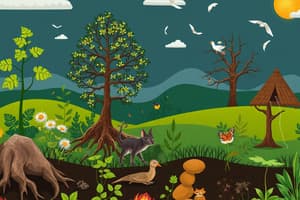Podcast
Questions and Answers
An ecosystem is a functional unit comprising all the organisms in a particular place interacting with one another and with their physical environment and interconnected by an ongoing flow of energy and a cycling of _______.
An ecosystem is a functional unit comprising all the organisms in a particular place interacting with one another and with their physical environment and interconnected by an ongoing flow of energy and a cycling of _______.
materials
Trophic structure is the way that energy and nutrients are transferred through an ecosystem. It is a way of organizing organisms into different levels based on their feeding _______.
Trophic structure is the way that energy and nutrients are transferred through an ecosystem. It is a way of organizing organisms into different levels based on their feeding _______.
relationships
Primary producers are organisms that can make their own food from sunlight, such as plants and _______.
Primary producers are organisms that can make their own food from sunlight, such as plants and _______.
algae
Photosynthetic autotrophs contain the green pigment chlorophyll in their organelles called chloroplasts which are able to trap the energy from the sun to fix carbon dioxide into carbon _______.
Photosynthetic autotrophs contain the green pigment chlorophyll in their organelles called chloroplasts which are able to trap the energy from the sun to fix carbon dioxide into carbon _______.
Chemosynthetic autotrophs oxidize inorganic compounds to obtain their energy and form carbon _______.
Chemosynthetic autotrophs oxidize inorganic compounds to obtain their energy and form carbon _______.
Primary consumers are organisms that eat the primary producers, such as _______.
Primary consumers are organisms that eat the primary producers, such as _______.
Trophic structure is the way that _______ and nutrients are transferred through an ecosystem.
Trophic structure is the way that _______ and nutrients are transferred through an ecosystem.
Primary producers can make their own food from _______.
Primary producers can make their own food from _______.
Primary consumers are also called _______.
Primary consumers are also called _______.
Decomposers play a crucial role in breaking down organic matter and recycling _______ in the ecosystem.
Decomposers play a crucial role in breaking down organic matter and recycling _______ in the ecosystem.
Secondary consumers primarily feed on _______.
Secondary consumers primarily feed on _______.
Trophic structure organizes organisms into different levels based on their feeding _______.
Trophic structure organizes organisms into different levels based on their feeding _______.
Chemosynthetic autotrophs obtain their energy by oxidizing _______ compounds.
Chemosynthetic autotrophs obtain their energy by oxidizing _______ compounds.
Heterotrophs must obtain their food from other _______.
Heterotrophs must obtain their food from other _______.
Photosynthetic autotrophs contain chlorophyll in their chloroplasts to trap energy from the _______.
Photosynthetic autotrophs contain chlorophyll in their chloroplasts to trap energy from the _______.
Trophic levels are a way of categorizing organisms based on their position in the _______ structure.
Trophic levels are a way of categorizing organisms based on their position in the _______ structure.
Flashcards are hidden until you start studying
Study Notes
- An ecosystem is a functional unit of organisms and their physical environment, connected by energy and material cycles
- Trophic structure is how energy and nutrients move through an ecosystem, organizing organisms into different feeding levels
- Primary Producers: autotrophs that make their own food through photosynthesis (using sunlight) or chemosynthesis (using inorganic compounds), include plants and algae
- Primary Consumers: heterotrophs that feed on primary producers, such as herbivores
- Trophic levels continue with secondary, tertiary consumers, and decomposers, each feeding on the previous level.
Studying That Suits You
Use AI to generate personalized quizzes and flashcards to suit your learning preferences.




